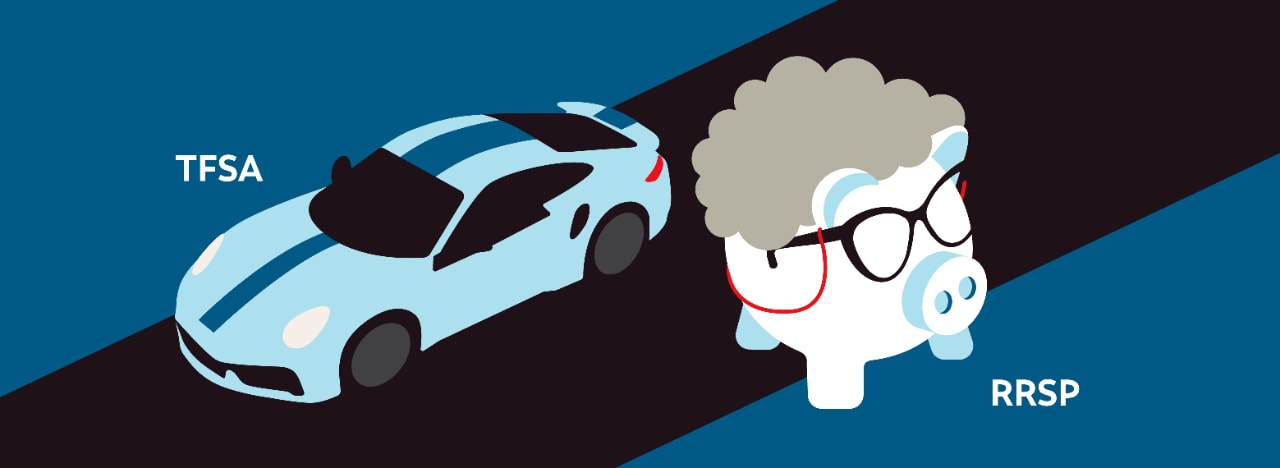Key takeaways:
Since it was rolled out in 2009, the TFSA has become one of the most popular ways to save. It lets Canadian residents who are at least at the age of majority, and have a valid social insurance number (SIN), to contribute each year — but there are rules on how much you can contribute.
Read on for all you need to know about TFSA contribution limit rules.
The annual tax-free savings account contribution limit is the maximum amount of money you can contribute to your TFSA account each year. Any amount you contribute to your TFSA throughout the year counts against what's called your "annual contribution room."
For 2025, the maximum contribution is $7,000. That's for new contributions only — your annual contribution room resets each year on January 1.
Your TFSA contribution room is based on the three factors:
- Yearly TFSA limit
- Any unused contribution room from previous years
- Any withdrawals from your TFSA the previous year
While the annual maximum contribution limit is the same for everyone eligible to open a TFSA, your personal contribution room will differ. That's because your total contribution room consists of the current year's maximum contribution limit, plus any unused TFSA contribution room you've accumulated from previous years.
Withdrawing from your TFSA doesn't reduce the total contributions you've made for the year. If you make a withdrawal, it's only added back to your TFSA contribution room at the beginning of the following year. So, for instance, if you make a withdrawal in 2025, it's not added back to your TFSA contribution room until 2026.
Not sure of your TFSA contribution room? It's easy to find out — just go to one of the following pages on the Government of Canada website:
- My Account
- My CRA
- Tax Information Phone Service (TIPS) at 1-800-267-6999
If you'd like to see how much you can save with a TFSA, you can use Scotiabank's TFSA calculator.
The TFSA program launched in 2009 as a way to set aside tax-free money. If you were 18 years or older at that time, your contribution room has been growing since then, and your total cumulative TFSA limit is now $102,000. If you turned 18 after 2009, your contribution room started the year you turned 18 and then began to accumulate.
Your TFSA contribution room grows every year even if you don't file a tax return or open a TFSA. If you aren't earning income, you can still contribute to your TFSA.
The annual TFSA contribution limit is indexed to inflation and rounded to the nearest $500. See the table below for the annual contribution limits and cumulative limits from 2009 to 2025.1
| Year | Annual contribution limit | Cumulative limit |
|---|---|---|
| 2025 | $7,000 | $102,000 |
| 2024 | $7,000 | $95,000 |
| 2023 | $6,500 | $88,000 |
| 2022 | $6,000 | $81,500 |
| 2021 | $6,000 | $75,500 |
| 2020 | $6,000 | $69,500 |
| 2019 | $6,000 | $63,500 |
| 2018 | $5,500 | $57,500 |
| 2017 | $5,500 | $52,000 |
| 2016 | $5,500 | $46,500 |
| 2015 | $10,000 | $41,000 |
| 2014 | $5,500 | $31,000 |
| 2013 | $5,500 | $25,500 |
| 2012 | $5,000 | $20,000 |
| 2011 | $5,000 | $15,000 |
| 2010 | $5,000 | $10,000 |
| 2009 | $5,000 | $5,000 |
If you over-contribute to your TFSA, there are consequences. You'll have to pay a tax equal to 1% per month on the excess amount,1 and you'll continue to pay that tax for as many months as the over-contributions stay in your account.
For example, let's say you reach your maximum contribution limit in November and, not realizing it, you contribute in December. As a result, you end up with an over-contribution of $500. In this case, you'll have to pay a 1% of $500 for November and December. Here's the math: $500 x .01 x 2 = $10.
While both the TFSA and a registered retirement savings plan (RRSP) are registered accounts that provide income tax benefits, they differ in important ways.

| TFSA2 | RRSP | |
|---|---|---|
| Who qualifies for the account? | Any Canadian resident or non- resident 18 years or older (or the age of majority in your province) with a valid SIN* | Any Canadian resident or non-resident of Canada under the age of 71 with a valid SIN |
| Tax-deductive contributions | No | Yes |
| Tax-free withdrawals | Yes | No |
| Maximum contribution limit | Subject to Canada Revenue Agency (CRA) regulations | Subject to CRA regulations |
| Deadline to close account | n/a | December 31 of the year you turn 71 is the last day you can contribute to your account |
*A non-resident can open a TFSA if they have a valid SIN, but they can't contribute into a TFSA. If they do so, there would be penalties.
You can take advantage of several benefits when you invest in a TFSA.
Your investment earnings grow tax-free
Unlike an RRSP, you don't get a tax deduction on your contributions to a TFSA. But all interest, dividends and capital gains earned in a TFSA are tax-free for life.
Your TFSA can also contain many types of investments, such as cash, mutual funds and exchange-traded funds (ETFs).
It's flexible
Unlike other registered accounts, like the RRSP and registered education savings plan (RESP), there aren't a lot of rules in terms of how you can use your TFSA. Other than sticking to the maximum contribution limit, you're free to save for whatever you want with your TFSA, and you can withdraw your money whenever you need it.

Many people use a TFSA to set aside money for short- and long-term goals, like the following:
- New car
- Vacation
- Wedding
- Emergency fund
- Home renovations
- Down payment on a house
- Retirement savings
- Education fund
There are no withdrawal penalties or taxes
When you want to make a withdrawal from your TFSA, you can withdraw as much as you want and you don't have to worry about paying penalties or taxes. Plus, you can re-contribute the amounts you've withdrawn the previous year or years, and your contribution room continues to carry forward.
TFSA withdrawals also won't reduce any income-based benefits, including Old Age Security or Employment Insurance benefits.
Contribution carry-over
If you don't contribute the maximum amount in a particular year, any unused contribution room carries forward.
Bottom line
The TFSA provides a flexible way to meet your savings goals. In 2025, the maximum contribution limit for a TFSA is $7,000. Don't worry if you won't be able to contribute the entire amount. Any unused contribution room will carry forward indefinitely into future years. If you plan to use the maximum contribution room, be sure to monitor your contributions so you don't go over the limit and have to pay the over-contribution penalty.
Sources:
1Government of Canada, "TFSA contributions."
2 Government of Canada, "Tax-free savings account (TFSA), guide for individuals."


